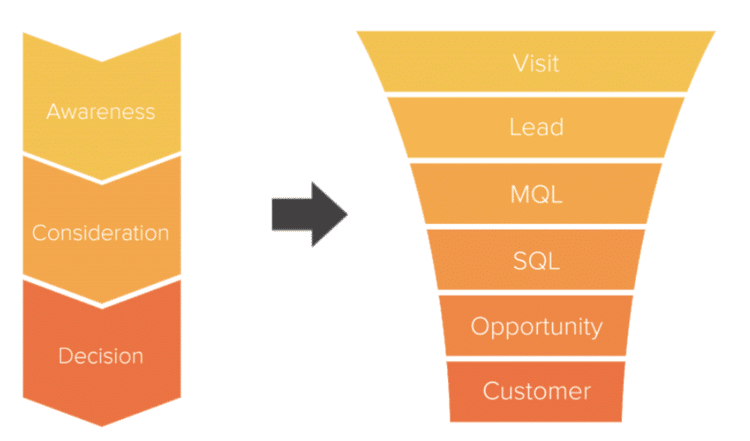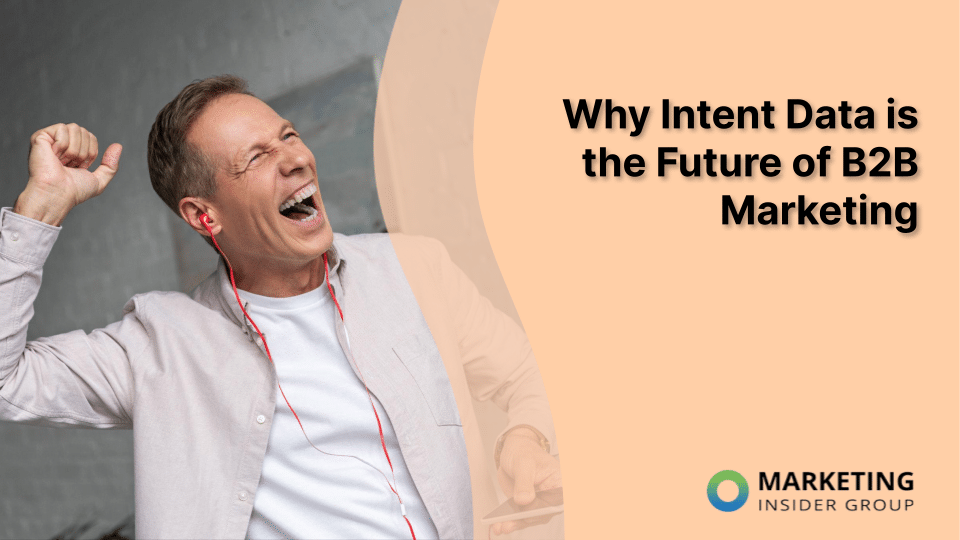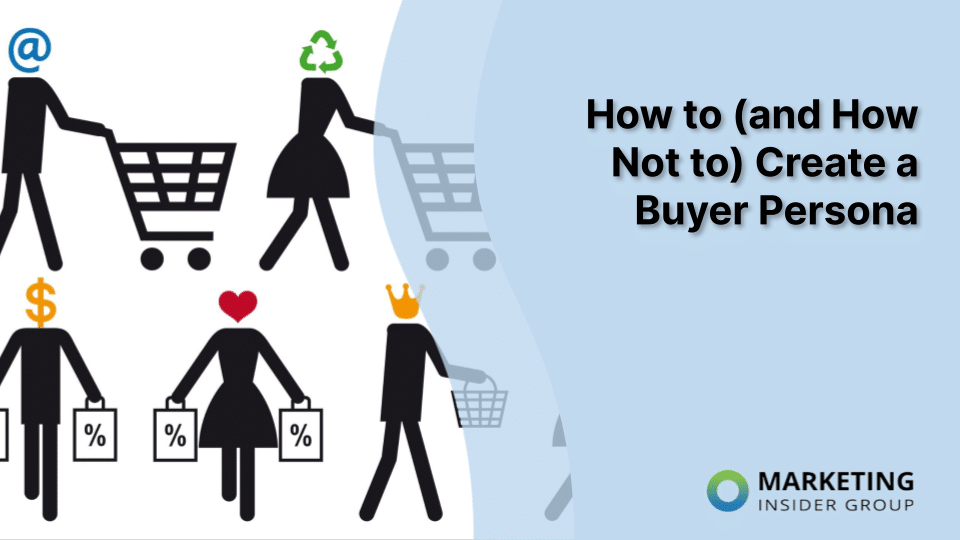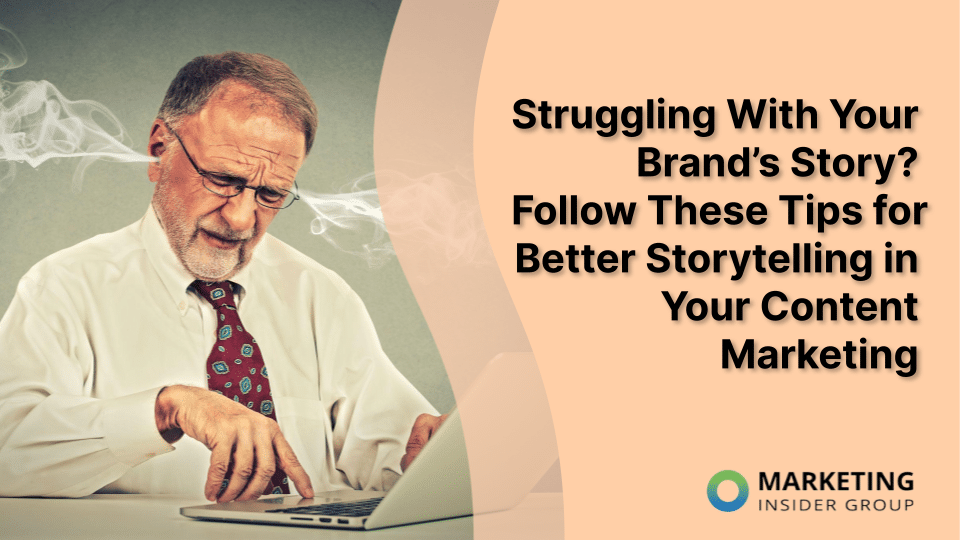
How to Supercharge Your Content Marketing for Buyer Intent
As a marketer, creating and publishing the right content in the proper context is essential. Many marketers can waste precious time, energy, and resources producing the wrong content for the wrong audiences.
That’s why we consider buyer intent to help our clients hone into their target audience to understand their needs better and give them what they’re seeking.
Using intent data will also help you create and distribute your content more effectively to reach the right people and add value at every stage of the buyer’s journey. It can empower you to educate, attract, and convert prospects into leads and loyal customers.

Source: HubSpot
Giving consumers content they crave can help you build trust, attract quality leads to your business, and increase engagement on your website to, ultimately, boost ROI for your business.
Quick Takeaways
- Many marketers waste their time, energy, and resources producing the wrong types of content for the wrong audiences.
- Intent data helps eliminate the guesswork, replacing it with concrete insights into when and where prospects explore what types of topics and solutions.
- You can collect two types of intent data to inform your efforts: internal and external.
- By identifying relevant topics and filling content gaps at every stage of the buyer’s journey, you can attract, engage, and delight prospects, leads, and customers.
- Understanding buyer intent can help your marketing team create more personalized and meaningful experiences, build greater trust with your audience, and better promote and syndicate content for maximum results.
What is Buyer Intent in Content Marketing?
Buyer intent is the intention of a buyer (or user) throughout their process of finding and purchasing a service or product. Marketers can use intent data to determine where prospects are in the buyer’s journey and deliver helpful and valuable information to lead them from one stage to the next.
Using data analytics tools, marketers can gather information about their users and measure the success of their marketing efforts. Tracking metrics like email open rates, keyword searches, demographic data, behavioral data, and engagement rates can all contribute to understanding your users’ intent.
Gathering this key information can help you identify how to attract the right audiences effectively, keep their attention, and eventually convert them into loyal customers.
Intent data helps eliminate the guesswork, replacing it with concrete insights into when and where prospects explore what types of topics and solutions. You can collect two types of intent data to inform your efforts: internal and external.
Internal Buyer Intent Data
Internal data is first-party information you can gather through your website (i.e., generating leads through landing pages, contact forms, subscriptions, etc.).
Many businesses collect contact information using gated content – like a form someone fills out in exchange for an ebook download. You can also gather internal intent data through a content relationship management (CRM) system or another marketing platform.
External Buyer Intent Data
You can only collect external intent data using a third-party provider. Third-party data comes from IP address lookups and shared cookies from thousands of websites across the internet. This type of data can tell you what content, brands, keywords, or topics are popular among audiences like yours.
How to Use Buyer Intent Data to Fuel Your Content Marketing Strategies
Understanding buyer intent can empower your marketing team to create more personalized and meaningful experiences for users at every stage of the buyer’s journey. It can also help you build trust with your audience and promote content more effectively for higher ROI. Here are some ways to use buyer intent to supercharge your content marketing efforts.
1. Understand Your Ideal Customers
If you don’t have a deep understanding of who your ideal customer is, you won’t know who to target through your content. So how can you expect to carry out an effective content marketing strategy? A firm grasp on your buyer personas is a prerequisite to understanding buyer intent and creating content that hits the mark.
Develop a deeper understanding of your audience by answering questions like:
- How do they think?
- What problems are they trying to solve?
- What answers are they seeking?
- What paths do they tend to follow to find solutions?
A buyer persona is a fictional representation of your ideal customer. By developing specific buyer personas for your business, you can better target real prospects by providing content that meets them where they are. Pull information from your contacts database, website forms, feedback from sales and customer services teams, and interviews to guide you.
You can fill out your buyer persona profiles with:
- Basic demographics
- Motivations (goals and challenges)
- Direct quotes from real customers
- Common objections to buying your products or services
2. Create Content for Each Stage of the Buyer’s Journey
Individuals and businesses often follow a common path on their journey to make a purchase. The journey often includes conducting research, weighing different options, and evaluating a solution before committing to a decision. To optimize this “buyer’s journey” for your prospects and customers, you can provide relevant content to help them make beneficial decisions along the way.
Most users start at an “unaware stage” – where they don’t yet understand what you offer or how it can help them solve their problem. Their buyer’s journey often begins when they encounter a new issue or want to find a solution to a pain point they’re facing. Once they do, they can jump into the awareness stage – or the top of the sales funnel.

Source: Hotjar
Those at the top of the funnel are further away from making a purchase than those at the bottom – who know what they want and how to get it. As a marketer, it’s your job to attract ideal consumers and engage them with relevant content at every stage.
Once your leads are qualified, you can hand them off to your sales team to engage them further and guide them toward making a purchase. After they become customers, your service team can then take over and delight them. In the long run, you want your current, return, and long-term customers to become loyal brand evangelists.
Stage 1: Awareness
In the first stage of the buyer’s journey, your goal is to attract the right audience by offering the right information at the right time to start meaningful relationships. Create content for the awareness stage by addressing common pain points and problems potential customers are facing.
Publish and share content that answers their questions and shows that you understand their frustrations. Your content should be primarily informative and educational, not promotional, at this stage. If prospects find your content useful, they may move to the second stage of their journey: consideration.
Content/channels for the awareness stage:
- Blog posts
- Social media
- Ebooks
- Whitepapers
- Videos
- Infographics
- Webinars
Stage 2: Consideration
During the consideration stage, prospects begin exploring different solutions. At this point, you’ve already captured your audience’s attention. They should have a basic understanding of the challenges they must address. It’s time to help them weigh their options and show them why your products or solutions are the best available – or if they should look elsewhere for a better fit.
Using intent data, you can identify which prospects are in the consideration stage and cater your messaging and content to address their specific needs. It’s an excellent time to familiarize consumers with your brand and continue building rapport. Providing answers and insights that align with consumer goals will help you build lasting relationships with people in the middle of the funnel.
Ultimately, your goal for this stage should be to engage consumers further and establish trust. If you can do that, your leads should move onto the next step in the journey: decision.
Content/channels for the consideration stage:
- Social media
- Retargeting campaigns
- Webinars
- Videos
- Product demos
- Case studies
- Free trials/samples
- Downloadable resources (e.g., how-to guides and slideshares)
- Comparison guides
Stage 3: Decision
The decision stage – at the bottom of the sales funnel – is where prospects become customers by making a purchase. Before this happens, however, you must engage with them and get them ready to buy. Your goal here is to position your brand as the best solution for the problem they need to solve.
At this stage, you’ve already warmed up your leads. They typically just need a final nudge in the right direction. You can compel them to act (purchase) by offering them the right content at the right time. This content might highlight how your products or services have benefited other customers and what prospects can expect by purchasing from you.
Use intent data like specific topics and keywords that relate to product/service categories and names, as well as other brand names consumers may be exploring. With this data, you can personalize your landing pages, product and service pages, emails, and offers to persuade prospects to buy.
Content/channels for the decision stage:
- Live chat
- Retargeting campaigns
- Free trials/samples
- Product demos
- Targeted offers
- Customer reviews and testimonials
- Detailed information (e.g., spec sheets and pricing options)
- FAQs
- Consultation offers
- Coupons
Stage 4: Loyalty
After winning new customers, remember to continue engaging them through content marketing to cultivate your relationships further. In the loyalty stage, you should add even more value, empower your customers to continue making beneficial decisions, and encourage them to promote your products and services to their family and friends.
Building brand loyalty doesn’t happen by chance. It often takes intentional marketing that goes above and beyond customer expectations. Continually engaging with your current customers shows them you care about their experiences and want to make them even better in the future.
Content/channels for the delight stage:
- Retargeting campaigns
- Loyalty programs
- Knowledge bases
- Surveys
- Newsletters
3. Personalize Your Content to Build Stronger Relationships
77% of B2B marketing and sales professionals think personalized marketing experiences lead to better customer relationships. 55% said marketing personalization leads to higher sales conversion and future growth rates.
Personalizing your content for different accounts or segments of your audience can help you connect with prospects and customers on a deeper level. You can personalize landing pages, emails, case studies, articles, and other types of content to help boost customer engagement.
Also consider leveraging artificial intelligence (AI) and machine learning to make the customer journey seamless and engaging for prospects and leads. An easy solution is adding a chatbot to your website that can answer commonly asked questions, guide prospects to the next stage in their journeys, and gather buyer intent for your business.
4. Promote and Syndicate Your Content
After you create content for every stage of the customer journey based on buyer intent, it’s time to promote and syndicate it for maximum visibility. Knowing which platforms and channels to distribute and share your content is just as important as creating it. If your promotion and syndication efforts fall flat, your content creation efforts could be in vain.
Consider investing in content promotion on the platforms your audience is using most. Using intent data (like demographic, geographic, firmographic, and behavioral information), you can also syndicate your content to those who will find it most valuable. First, identify who is searching for content and solutions like yours. Then you can reach out directly and share your content via email and targeted advertising campaigns.
Optimize your online content, digital advertising, email marketing, and more using buyer intent for the best results.
- Business website: When your website content is highly relevant, more visitors will naturally want to stay on your site longer and be more likely to engage. This can help boost your overall SEO by sending signals to search engines that your site and content are trustworthy and engaging.
- Advertising campaigns: Buyer intent data can help you optimize your advertising campaigns to reach more of the right audience. By understanding what topics your audience finds helpful and interesting, you can optimize your ad copy to increase click-through rates and ROI.
- Email marketing: Dividing your email list into segments based on where your contacts are in the buyer’s journey is a great way to send targeted messages that gets results. You can improve your open and click-through rates by providing relevant content to different email lists.
Use Buyer Intent to Maximize Content Marketing Results
Here at Marketing Insider Group, we can create engaging, high-quality, SEO-driven content to help you reach and engage consumers at every stage of the buyer’s journey. We consider buyer intent throughout the entire process: from content creation to distribution and promotion.
We will create a customized strategy that includes all the content you’ll need to win new customers for your business. We’ll also help you measure and calculate ROI. On average, our clients see a 138% growth in organic search traffic year over year.
Our team of experts will thoroughly research your target audience to gain an in-depth understanding of your buyer personas. That way, we can develop keyword-rich content that meets your prospects where they are and helps lead them seamlessly through the buying process. We offer SEO audits, regular content creation (including long-form content), landing page copy, promotion, and more.
Contact us to learn more about our Content Builder Services.
Photo by Anna Shvets from Pexels






